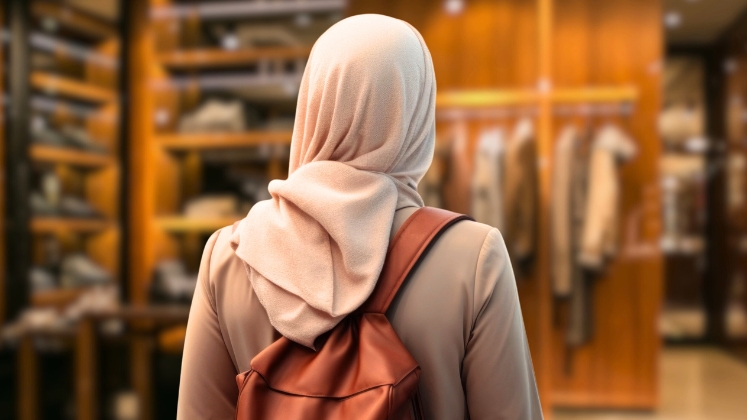In the last two months, Bangladesh has welcomed top international brands Levi’s and Adidas, which have opened their first stores in the country. Prior to this, brands like Nike, Puma, Decathlon and Being Human had already established a presence there. Concurrently, Bangladeshi brands such as Yellow, Rise, Aarong, Noir, Fit Elegance, Amirá, Sailor and Le Reve amongst many others are also experiencing growth. These developments
indicate that Bangladesh’s US $ 10 billion domestic apparel market is continually evolving.
However, the retail market in Bangladesh faces the challenge of seasonal business. Major purchases in the apparel retail market primarily occur during specific festivals like Eid and Durga Puja. For the rest of the year, the market generally experiences routine or lean periods.
To address this issue, apparel retail companies are undertaking various initiatives such as emphasis on loyalty programs and effective monitoring of footfall to maximise the value of efforts and ultimately increase sales.
Retailers are proactively working to attract customers even outside of festival periods. By building a community around their brand, they aim to engage with customers year-round rather than just during major festivals. Efforts include creating unique in-store experiences and leveraging influencers.
Loyalty programs taking centre stage to increase repeat rate
Loyalty programs are increasingly essential for building a loyal customer base with minimal investment, as retaining customers is more cost-effective than acquiring new ones. These programs also gather valuable shopping data such as preferred categories, seasonal trends and brand affinity. This data fuels personalised content and offers, enhancing program effectiveness.
One of the oldest homegrown fashion retailers in Bangladesh, Yellow, started its loyalty program journey almost 8 years ago when the concept was new to the industry. The ‘YELLOW ADMIRE’ Loyalty Card program has been designed to enrich customer experiences with exclusive benefits that transcend mere transactions. More than just a token of appreciation, this program promises to redefine customer loyalty with a host of exclusive benefits.
This complimentary card offers members access to ‘Beyond Price’ experiences such as international concerts and cricket matches, alongside free surprise gifts and offers that celebrate their loyalty. Members also receive exclusive invitations to premier fashion shows and enjoy special discounts on designated ‘Loyalty Card Day’ events.
| The loyalty programs are structured initiatives to incentivise repeat purchases and cultivate lasting relationships with customers and a study by McKinsey says that customers in high-performing loyalty programs are not only 62 per cent more likely to spend more, but they are also 59 per cent more inclined to pick that brand over a rival. Globally, customers are becoming concerned about loyalty programs as a recent survey by Bizrate Insights also says that 61 per cent of US adults value loyalty programs that are tailored to their shopping preferences. |
“If you’ve successfully connected with a customer through marketing and they’re familiar with your store’s location, engagement becomes more straightforward compared to reaching out to new prospects who aren’t yet aware of your store or brand,” explains Shehryar Burney, Executive Director of Yellow. Established under the Beximco Group, the 20-year-old brand Yellow offers a diverse selection of men’s, women’s, kids and newbornwear through its 19 stores spread across the country.

Similarly, RISE, a retail establishment under the Standard Group, offers a ‘Loyalty Club Card’ to recognise and reward its loyal clientele. This privileged membership is granted based on specified purchase criteria either in-store or online. “Members enjoy various benefits including discounts on regular-priced apparel items, special birthday discounts as well as exclusive offers at selected resorts and spas and international hotel chains,” comments Faheem Mosharraf, Managing Director, RISE.

Even traditional retail stores like Aarong feature Club TAAGA with three membership tiers, each offering rewards and exclusive privileges. Members earn points on every purchase and can access benefits through various partners. Additionally, its ‘MY AARONG REWARDS’ program includes four categories with diverse benefits and exclusive offers. Similarly, Being Human Bangladesh launched a rewards program where customers can sign up online or in-store, confirming their membership to begin saving on subsequent purchases immediately.
Commenting on the significance of Loyalty Programs from Bangladesh’s perspective, Zainab Maqsood, Founder of Amirá (a retail brand by Experience Group), a Bangladeshi high-street brand with four stores, says, “There’s a prevalent issue in the market where many customers fail to distinguish between new seasonal releases and older items. They often purchase random styles without realising whether they belong to the current season or previous ones. My team and I are still working hard to address this challenge effectively through our Loyalty Campaigns.”

At Amirá, customers earn points with every purchase through membership cards. These points can be converted into cash rewards that they can use for future purchases. “It’s our way of rewarding loyalty and making shopping with us even more rewarding. We’re currently exploring ways to enhance satisfaction among our premium customers by offering compelling bonuses that truly highlight their status as our top clients. I have some innovative ideas for near future that I believe will attract everyone to join our premium customer program,” mentioned Zainab whose stores feature various marketing activities, including touch screens and spinning wheels, to enhance customer engagement.
With e-commerce expanding in Bangladesh, more brands and retailers can strategically implement loyalty programs to engage both current and potential customers across physical stores and online platforms.
| Personalised experiences are also constrained within traditional retail stores, as tracking customer preferences manually proves difficult. Consequently, opportunities for tailored recommendations and promotions are missed. |
Advancing footfall monitoring in Bangladesh apparel retail
Alongside running loyalty programs, monitoring footfall is crucial for assessing efforts to attract customers to stores. Proper monitoring provides an accurate gauge of increased foot traffic, essential for evaluating success in drawing customers.
Currently, many Bangladeshi brands rely on manual record-keeping or lack technology for accurate footfall monitoring, despite recognising its importance. However, some retailers like DBL Lifestyles offering brands such as Puma, Levi’s and Adidas in Bangladesh, employ technology-driven solutions. Rezwan Habib, Head of Operations at DBL Lifestyles, explains their approach, “We use a people counting system with cameras positioned strategically to prevent double counting. This gives us exact data of how many people visited our stores and then we further analyse how many turned up as shoppers.”

Tracking footfall serves multiple purposes for retailers like DBL Lifestyles. It helps gauge sales team effectiveness in converting foot traffic to customers and aids in staffing decisions. Furthermore, accurate footfall data informs about promotional strategies, store layout, product placement, pricing adjustments and enhances overall customer service.
Rehan Rahman, Director of Being Human Bangladesh, emphasises his approach, “We keep track of non-customers along with footfall – those who visit the store but haven’t made a purchase – and explore the reasons behind their decision. It could be related to pricing, size availability or design preferences. Therefore, at the end of each week, we analyse these issues and take appropriate remedial actions.” Being Human Bangladesh, currently operating four stores, aims to expand its footprint aggressively across Bangladesh.

Going forward, the industry believes in keeping pace with the global trends and using various technologies such as thermal imaging and AI-powered footfall counters to ensure precise measurement across different conditions, accurately counting individuals and groups.
Advantages of having an experiential retail store• These stores can help to raise brand awareness and visibility, which can lead to increased sales in both the physical and online stores. • Such stores can provide a more engaging and satisfying shopping experience for customers, which can lead to repeat visits and increased sales. • Experiential retail stores can be used to gather customer feedback and data, which can be used to improve the products and services offered. •These stores can help to reduce costs and risks by eliminating the need for traditional advertising and marketing campaigns. |
Addressing seasonality factor
The apparel retail industry in Bangladesh experiences revenue fluctuations due to seasonality. To mitigate these challenges and stabilise revenue, retailers can adopt several strategies such as Diversifying Product Lines; Introducing Non-Seasonal Products; Specialty Collections for Non-Peak Seasons; Enhancing Online Presence; Off-Season Sales; and Cross-Promotions.
By adopting these strategies, retailers in Bangladesh can better manage the impact of seasonality on their revenues, ensuring more stable and sustainable business operations throughout the year.
More ways to engage customers in-store
Experiential stores are a major talking point among the retail fraternity these days. While the western world is incorporating new-age store innovations to enhance customers’ in-store experience, Bangladesh fashion retailers should also catch up with this trend, much like their Indian counterparts. However, the biggest question arises – what does a fashion retail market like Bangladesh require to engage customers in stores and turn them into shoppers?
Convenience remains limited in conventional retail set-ups, with time-consuming checkout queues. One key challenge is limited inventory due to physical space constraints, resulting in frustrated customers unable to locate desired items. According to an Accenture report, shoppers who had a frustrating shopping experience are three times more likely than satisfied consumers to not buy from the retailer or brand again! Another hurdle is the scarcity of detailed product information, including size, colour and style choices. This deficiency can prompt customers to leave without purchasing.
Personalised experiences are also constrained within traditional retail stores, as tracking customer preferences manually proves difficult. Consequently, opportunities for tailored recommendations and promotions are missed. Technology, employing data analytics and AI algorithms, can overcome this obstacle by monitoring customer behaviour and providing personalised suggestions.
A smart retail store goes beyond addressing the touchpoints of its target audience by also providing compelling reasons for customers to visit often, allowing retailers to increase their market share. There are numerous ways in which a traditional bricks-and-mortar store can evolve into a smart retail store and address consumers’ pain points such as long queues and frustration due to less visibility into inventories.








